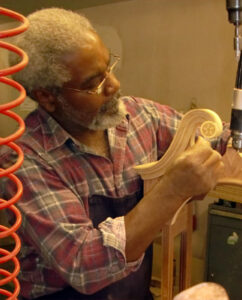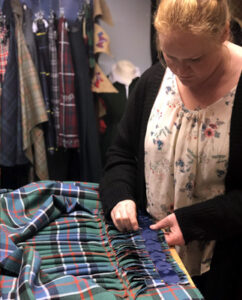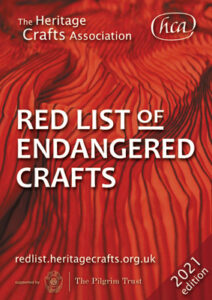Craft skills under threat with 27 additions to the HCA Red List of Endangered Crafts
23rd July 2021 | ANNOUNCEMENTS

Barometer making at O Comitti & Son Ltd, a critically endangered craft
New research by the Heritage Crafts Association has unearthed more traditional craft skills on the verge of extinction in the UK, in the latest major update of its pioneering project, the HCA Red List of Endangered Crafts.
The research, which has been funded by The Pilgrim Trust, has found that COVID-19 has only exacerbated the issues faced by our most at-risk skills, after a year that has seen many craftspeople pushed to the brink.
- Click here to go to the HCA Red List
- Click here to view the 2021 list of crafts
- Download the press release
20 new crafts have been added to the ‘critically endangered’ category of the HCA Red List, meaning that they are at serious risk of dying out in the next generation, including diamond cutting, mouth-blown sheet glass making, pointe shoe making and glass eye making. They join the list of 130 endangered crafts, including eight that have been reclassified as being at a higher level of risk than when the research was last updated in 2019.

Kiltmaking at The Kiltmakery, an endangered craft
Critically endangered crafts include those with very few practitioners, few (if any) trainees and a lack of viable training routes by which the skills can be passed on. Often they serve very niche markets, and craftspeople cannot afford to step away from production to train their successors for fear those markets will disappear.
It’s not all bad news, however, as no new crafts have become extinct in the past two years, and some, such as gilding and pole-lathe bowl turning, have seen an upturn in their fortunes. In many cases this has been as a result of a new-found appreciation of the handmade and the need to support small businesses during the pandemic. In others it has been due to direct support from the Heritage Crafts Association, which since the publication of the last edition of the HCA Red List has distributed 27 grants of up to £2,000 each as part of its Endangered Crafts Fund.
Mary Lewis, who led the research on behalf of the Heritage Crafts Association, said:
“COVID-19 has been tough on everyone, not least the craftspeople who possess our most fundamental craft skills. Society is rapidly changing around us, and it is more important than ever that we are aware of the cultural assets still available to us, so that we can have an informed debate about what we want to safeguard as a resource for the future. If we allow endangered crafts to disappear then we seriously diminish the opportunities for future generations to create their own sustainable and fulfilling livelihoods, based on these skills.”
Whilst the UK has been a world-leader in the preservation of tangible heritage (museum collections, buildings and monuments), it has fallen behind the rest of the world when it comes to the safeguarding of intangible heritage (knowledge, skills and practices). Of 193 UNESCO members, the UK is one of just 13 that have not yet ratified the 2003 Convention on the Safeguarding of Intangible Heritage, and government responsibility for heritage crafts falls in the gap between agencies set up to support arts and heritage.
Sue Bowers, Director of The Pilgrim Trust, said:
“We are delighted to support the continuing development of the Red List which is so important in tracking the state of heritage crafts in the UK and creating the platform for discussions about how we can bring about positive change in the future.”
The HCA Red List of Endangered Crafts 2021 edition is available to view online at http://redlist.heritagecrafts.org.uk.
About the HCA Red List of Endangered Crafts
 The 2021 edition of the HCA Red List of Endangered Crafts was led by Mary Lewis, HCA Endangered Crafts Manager, supported by The Pilgrim Trust. The project runs alongside Mary’s work in identifying and developing interventions to improve the prospects of such crafts, funded by The Swire Charitable Trust, The Garfield Weston Foundation and The Dulverton Trust.
The 2021 edition of the HCA Red List of Endangered Crafts was led by Mary Lewis, HCA Endangered Crafts Manager, supported by The Pilgrim Trust. The project runs alongside Mary’s work in identifying and developing interventions to improve the prospects of such crafts, funded by The Swire Charitable Trust, The Garfield Weston Foundation and The Dulverton Trust.
For the 2021 edition, 244 crafts have been assessed to identify those which are at greatest risk of disappearing. Of the 134 crafts featured on the Red List, four have been classified as extinct, 56 as critically endangered and 74 as endangered. The remaining 110 are classed as currently viable.
Drawing on information such as the current number of craftspeople and trainees, the average age of practitioners, opportunities to learn, and other issues affecting the future of the crafts, including the impact of COVID-19, the research assesses how likely it is that the craft skills will be passed on to the next generation. From armour making and arrowsmithing to wig making and woodturning, each has been assigned to one of four categories: extinct, critically endangered, endangered or currently viable.
Four crafts are known to have become extinct in the UK in the last fifteen years (cricket ball making, gold beating, lacrosse stick making, and paper mould and deckle making) with one more (sieve and riddle making) brought back from extinction.
New crafts for 2021
New critically endangered crafts (crafts classified as ‘critically endangered’ are those at serious risk of no longer being practised in the UK. They may include crafts with a shrinking base of craftspeople, crafts with limited training opportunities, crafts with low financial viability, or crafts where there is no mechanism to pass on the skills and knowledge.)
- Barometer making
- Bowed-felt hat making
- Brilliant cutting
- Coiled straw basket making
- Compass making
- Copper wheel engraving
- Currach making
- Diamond cutting
- Fabric pleating
- Frame knitting
- Glass eye making
- Hazel basket making
- Highlands and Islands thatching
- Horsehair weaving
- Mouth-blown sheet glass making
- Pointe shoe making
- Shetland lace knitting
- Silver spinning
- Sporran making
- Wooden fishing net making
New endangered crafts (Crafts classified as ‘endangered’ are those which currently have sufficient craftspeople to transmit the craft skills to the next generation, but for which there are serious concerns about their ongoing viability. This may include crafts with a shrinking market share, an ageing demographic or crafts with a declining number of practitioners.)
- Hat making
- Kilt making
- Lithograpy
- Skeined willow working
- Sofrut calligraphy
- Spectacle making
- Type founding and manufacture
About the Endangered Crafts Fund
The Heritage Crafts Association’s Endangered Crafts Fund was set up in 2019 to ensure that the most at-risk heritage crafts within the UK are given the support they need to thrive. The Fund is used to support makers and trainees who wish to develop or share their skills in the crafts that have been identified as being most at risk.
To date, 27 projects have been funded with support from the Garfield Weston Foundation, the Dulverton Trust, the Sussex Heritage Trust, Allchurches Trust, the Radcliffe Trust and the Swire Charitable Trust.
Anyone wishing to donate to the fund may do so securely online. Alternatively, please send a cheque made payable to ‘Heritage Crafts Association’ with an accompanying note specifying ‘Endangered Crafts Fund’ to: Heritage Crafts Association, 27 South Road, Oundle, Peterborough PE8 4BU.
About the Pilgrim Trust
The Pilgrim Trust is an independent grantmaking trust that supports the urgent and future needs of the UK. It gives approximately £3 million in grants per year to charities and other public bodies that either focus on preserving the UK’s heritage or catalysing social change. Its preservation and scholarship fund aims to preserve the fabric of historically important buildings and to conserve significant collections and artefacts. It wants present and future generations to enjoy the rich and diverse heritage found throughout the UK.
